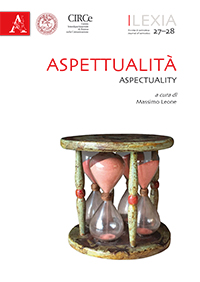Estratto da
LEXIA. RIVISTA DI SEMIOTICA
Aspettualità / Aspectuality
L’aspettualità nella lingua. Marcature morfologiche ed effetti di soggettività
LEXIA. RIVISTA DI SEMIOTICA
Aspettualità / Aspectuality
L’aspettualità nella lingua. Marcature morfologiche ed effetti di soggettività

While tense is a deictic category that implies an explicit or implicitreference to the time of enunciation, or to when action occurs, aspectis a non–deictic category, which does not imply any reference to thetime of enunciation but only to how the action takes place. Aspects areways to see the temporal internal structure of a situation and in this sense constitute as many subjective attitudes. Grammatical categoriesof particular languages often combine the aspect (implying notions ofthe completeness or incompleteness of an action) with tense (indicatingrelations of precedence and succession).Within the aspectual dimension,three notions, which are often confused, are to be distinguished,. Thefirst is that of aspect in a proper sense, articulated in the perfectiveand imperfective dimension. It is a grammatical notion that involves amorphological mark and affects the whole verbal system. The secondnotion concerns what is sometimes referred to as “Aktionsart” (modeof action), which is realized by derivation or composition and has asusual formal marking some prefixes or affixes. It is not general in thesense that it does not concern the whole of the verbal system, but onlylexical differences. The third notion concerns the semantic aspectualcomposition of certain verbs, independently from any morphologicalmarking. The aspect is a phenomenon that, in a proper sense, can onlybe found in linguistic systems: in non–linguistic systems we can speakof aspects only in a metaphorical sense.
| pagine: | 65-86 |
| DOI: | 10.4399/97888255087653 |
| data pubblicazione: | Giugno 2017 |
| editore: | Aracne |








